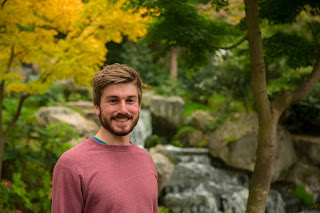"The last time I was here, I was reporting
on the success of BSBI Kerry’s first ever outing to Ross Castle, Killarney.
 |
Clouds clearing to reveal more of the
Sliabh Mish mountains
Image: J. Hamilton |
"This time I’m reflecting on our second outing that took us to
Blennerville and out alongside the Canal which eventually enters scenic Tralee
Bay.
"Led by Therese and myself, as with our
previous outings, we had botanists of all levels and it was great to be faced
with so many familiar faces as well as lots of newcomers and some of my fellow
classmates from the IT Tralee.
"This time our foray started opposite
Blennerville windmill.
"From there we then planned to head down across the road
and alongside the canal.
 |
Sea Mayweed
Image: J. Hamilton |
"Before we did this, as the carpark fell in our first
monad, we decided to start right there.
"Many a botanist knows how interesting car parks
can be in terms of what botanical surprises they can throw up.
"Nothing too alarming
came up for us, lots of typical common species and it gave a people to have a
go keying out a very common Cerastium fontanum (common mouse ear).
 |
Marsh Cudweed
Image: J. Hamilton |
"As the car park backed onto a nearby salt
marsh, we quickly crossed off a few salt marsh species such as Plantago maritima
(Sea plantain), Aster tripolium (Sea aster) and so on.
"After leaving the car park we set along the
canal when the clouds cleared to reveal hints of blue sky.
"Quickly we came
across a waste-ground type patch and in quick succession we were soon crossing off lots of species.
 |
Scarlet Pimpernel
Image: J. Hamilton |
"Nothing too rare or overly exciting but we
got lots of common stuff which in the grand scheme of things are just as
important as the rare things.
"The fact that we saw lots of common things
such as different species of thistle and vetch growing side by side gave people a chance to see many species of the same family growing side by side.
"They were able to note their
differences and ID features that they could apply again in the future.
"One nice
plant which I for one don’t come across too often was Gnaphalium uliginosum
(Marsh cudweed).
 |
Wild Carrot seedhead
Image: J. Hamilton |
"The common Anagallis arvensis (scarlet
pimpernel) was a hit as always with everyone, especially as the day was
brightening and the flowers were starting to open.
"Geranium dissectum (Cut-leaved crane’s-bill), another favourite of mine, was scrambling up amongst
grasses. The twisted seed heads of Daucus carota (Wild carrot) stood out on top
of a grassy mound nearby.
"A nice moment to see was when people looked
through their hand lenses and noticed the little points on the leaflets of
Medicago lupulina (Black medick).
 |
Black Medick
Image: J. Hamilton |
"Beside the waste ground/grassy area were
swathes of Bolboschoenus maritimus (Sea Club-rush).
"As we walked further along canal we
encountered lots of coastal species such as Scurvy grass, Thrift, Sea Beet
& a few gone over examples of sea milkwort.
"We also encountered the last of
the species of plantains (Plantago spp.) that we expected to see on the day
giving us all four:
P. lanceolata, major, maritima and coronopus.
 |
Teasels by Tralee Bay
Image: J. Hamilton |
"Across the canal on the wall of a dwelling
I could see flecks of purple, and thanks to Kilian’s binoculars we were able to
add another two species to the list: Cymbalaria muralis (Ivy-Leaved toadflax) and Asplenium scolopendrium (Hart’s tongue fern).
"A break was taken to refuel and chat, this
time giving grand views of Tralee Bay and the Sliabh Mish mountains with
towering examples of gone over teasel adding some nice perspective to our
lunchtime views.
 |
Keying a speedwell
Image: J. Hamilton |
"In this area we ticked off more species including Coronopus
didymus (Lesser Swine-cress) with its unmistakable odour when crushed.
"We then kept strolling and left the coastal
habitats behind us in favour of roadside and hedgerows hoping the change in
habitats would allow us to tick off a few more species, which it surely did.
"Lots of common species popped up such as Stachys sylvatica (Hedge woundwort),
Sonchus arvensis (Perennial sow-thistle) and Arctium minus (Lesser Burdock).
 |
Perennial sow-thistle
Image: J. Hamilton |
"One species however it took a while for us to find was the normally quite plentiful Geranium robertianum (Herb-Robert) but after a while we found one plant looking less than happy on top of a stone wall.
"These stone walls also yielded three more ferns Asplenium trichomanes (Maidenhair spleenwort), Asplenium ruta-muraria (Wall rue) and Polypodium vulgare (Common Polypody).
"Nearby at a field gate entrance I got to
practice keying out a fumitory which yielded Fumaria bastardii (Tall ramping
fumitory).
 |
Investigating a vetch
Image: J. Hamilton |
"All in all, we covered two monads and
recorded over 100 species.
"Remember:
- You can follow our antics on the official
BSBI Kerry Facebook page here
or if you’re a Twitter user here.
- If you are in the Kerry locality and would
like to get involved and come out with us on future outings, send an email to
Jhbsbikerry@gmail.com and I’ll add you to the mailing list".
Many thanks to Jessica for this account and for providing so many great photos - it sounds as though the Kerry BSBI group is going from strength to strength! We'll keep you posted on their progress on these pages.















